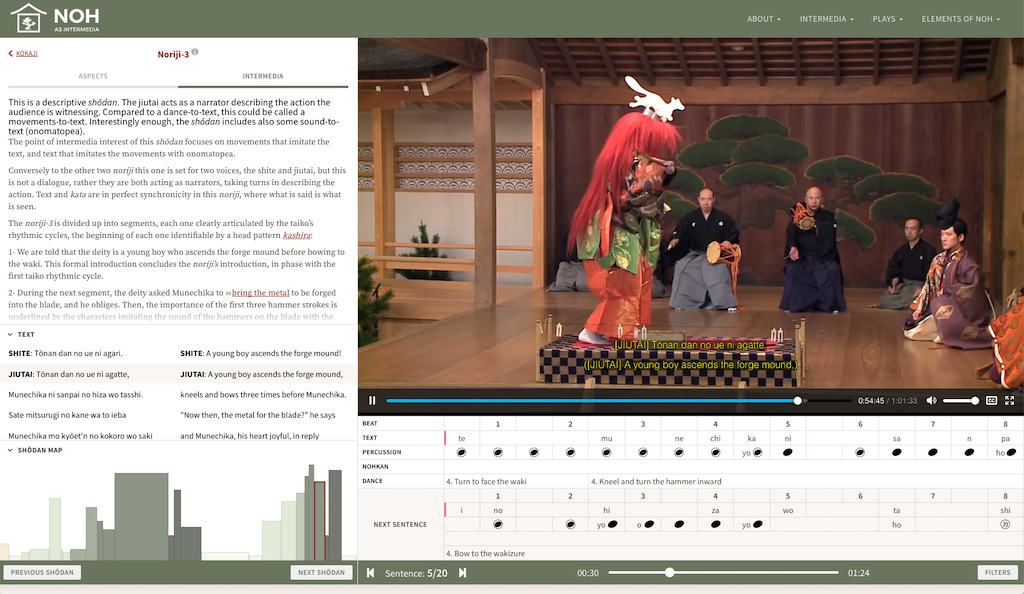1. Abstract
The Noh as Intermedia project uses web-based technologies for interactive annotation and visualization of performing arts materials to investigate and present how Japanese Noh theater exemplifies intermedia. “Intermedia” here is defined as a way of forming expression that draws on relationships between art forms (literature, vocal and instrumental music, stage movement, dance, masks, costumes, and props, in the case of Noh) and their cumulative impact.
To untangle some of the unique “coming together” of artistic media in Noh, the project site builds a multi-scale, “thick” analysis around high-resolution video recordings of live performances of two exemplary and contrasting Noh plays, Hashitomi and Kokaji, which were both likely written in the late 14th century CE. The examination moves from high-level essays describing the genre and history of Noh and the two plays to a middle-level set of interactive catalogs, descriptions, and image, video and audio examples presenting the varied and often highly systematized media elements that comprise a Noh performance. These include theatrical and dramatic forms at the macro and meso scales, poetic modes of declamation and singing, dance patterns and other gestures, instruments, rhythmic and melodic modes and musical forms, as well as costumes, masks, stage positioning and props.
 Fig. 1: A faceted catalog of sh?dan (formal sections of a play)
Fig. 1: A faceted catalog of sh?dan (formal sections of a play)
At the most finely detailed level, the project provides a novel playback and annotation environment that is synchronized at subsecond-level granularity with the streaming video playback, combining plot synopses, visualizations of formal sections, and synchronized libretto translations with a multilayered, multimedia score that encodes every sung or spoken word, musical element, and stage action. This score thus represents, for a specific performance, even the components of a play that are not traditionally notated, such as elements of the musical accompaniment. In an analogous manner, this entire mode of presentation has the effect of exposing, in an immediately engaging and comprehensible way, the myriad subtle details of a Noh performance whose interplay across media types lends the performances their extraordinary richness, yet which would otherwise likely go unremarked by those who are not already experts in the genre.
 Fig. 2: The interactive playback environment, with synchronized score, text, formal map and description
Fig. 2: The interactive playback environment, with synchronized score, text, formal map and description
The site also engages with the tensions between providing interactive, multimedia visualization and annotation features that are highly tailored to a specific performance genre (Noh, in this case) versus having the flexibility to accommodate other genres and art forms within the same framework. In our project, we found that favoring the specific over the general provided the greatest degree of interpretive insight, but it consequently required a greater effort to integrate other genres, particularly if these other forms are to be presented at equivalent levels of coherence and clarity.
References
Bethe, Monica, and Karen Brazell. Dance in the N?o Theater. Ithaca, N.Y.: China-Japan Program, Cornell University, 1982.
Chion, Michel. L’audio-Vision: Son et Image Au Cinéma. Nathan, 1990. Later translated as Chion, Michel, and Claudia Gorbman. Audio-Vision: Sound on Screen. Columbia University Press, 1994.
Cook, Nicholas. Analysing Musical Multimedia. Clarendon Press, 1998.
Hare, Thomas B. Zeami's Style: The Noh Plays of Zeami Motokiyo. Stanford, Calif: Stanford University Press, 1986.
Higgins, Dick with an appendix by Hannah Higgins. “Synesthesia and Intersenses: Intermedia.” Something Else Newsletter 1. Something Else Press, 1966.
Konparu, Kunio. The Noh Theater: Principles and Perspectives. Warren, Conn: Floating World, 2005.
Tamba, Akira. The Musical Structure of No?. Tokyo: Tokai University Press, 1981. Originally Tamba, Akira. La Structure Musicale Du No?: The?a?tre Traditionnel Japonais. Paris: Klincksieck, 1974.